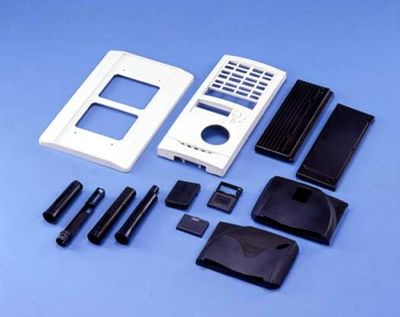Thermo Plastics
Those plastics which can be easily softened again and again by heating are called thermoplastic.
They can be reprocessed safely. They retain their plasticity at high temperature, i.e. they preserve an ability to be repeatedly formed by heat and pressure. Therefore, they can be heated and reshaped by pressing many times. On cooling they become hard. They are some times also called as cold-setting plastics. They can be very easily shaped into tubes, sheets, films, and many other shapes as per the need.
Types of Thermo Plastics
(A) Amorphous
1 Polystyrene
2 Acrylonitrite-butadiene-styrene
3 Mrthacrylate
4 P.V.C (Polyvinyl chloride)
5 Polychloroacetal
6 Auorinated polymers,
7 Polycarbonate etc.
(B) Crystalline
1 Polyethylene
2 Polyamides
3 Polyacetal
4 Polypropylene
The reason for the re-softening of thermoplastic resins with heat is that they are composed of linear or long chain molecules. Application of heat weakens the intermolecular bonds by increasing thermal agitation of the molecules, and the material softens and thus plastic can be easily molded and remolded without damage
Thermo-Setting Plastics
Those plastics which are hardened by heat, effecting a non-reversible chemical change, are called thermo-setting. Alternatively these plastics materials acquire a permanent shape when heated and pressed and thus cannot be easily softened by reheating. They are commonly known as heat-setting or thermosets.
Thermosetting resins
(i) Phenol-formaldehyde resins
(ii) Urea-formaldehyde resins
(iii) Melamine-formaldehyde resins
(iv) Polyester resins
(v) Epoxy resins
(vi) Silicone resins
Other thermosetting compounds are phenol furfural, polysters, alkyds, and polyurethanes. The most common thermosetting compound is phenol formaldehyde which is discussed as under.
Phenol formaldehyde
Phenol formaldehyde is called as bakelite due to the name of its inventor Bakelite. It is the most commonly and widely used plastic. It is made by the reaction of phenol with formaldehyde. It has high strength, hardness, stability, rigidity and can be easily casted or laminated. It is highly resistant to heat, electricity and water. It is made in dark color shades. Its general uses are in making articles such as stereo cabinets, radio cabinets, plugs, knobs, dials, bottle cap, pulleys, wheels, telephones, switches and handles.
Thermosetting resins, when subjected (once only) to the heat and pressure required for forming, change into a hard and rigid substance. Once done so, they cannot be softened again by the application of heat. The reason for the above phenomenon is that the thermosetting plastics consist of linear, relatively low molecular weight thermoplastic polymer chains with cross-links which bond the chains together with primary valence bonds. Such three-dimensional polymers, once cross-linked, will not soften when heated (but may decompose disintegrate at higher temperatures) because this process is an irreversible chemical reaction and the entire structure becomes essentially a single molecule. In contrast the thermoplastic resins can be re-softened and remolded by application of heat and pressure. They retain their plasticity at high temperature, i.e. they preserve an ability to be repeatedly formed by heat and pressure.
Reference Introduction to basic Manufacturing Processes and Workshop Technology by Rajender Singh.
For engineering project visit this page regularly for know more things related project ideas. Click here to see Ideas of Projects. Engineers Gallery. All the Best!















Post Comment
You must be logged in to post a comment.